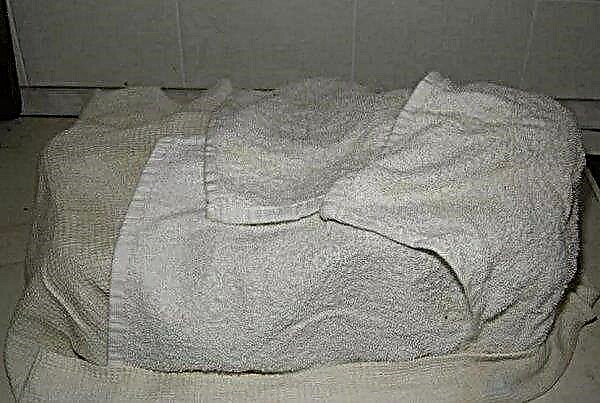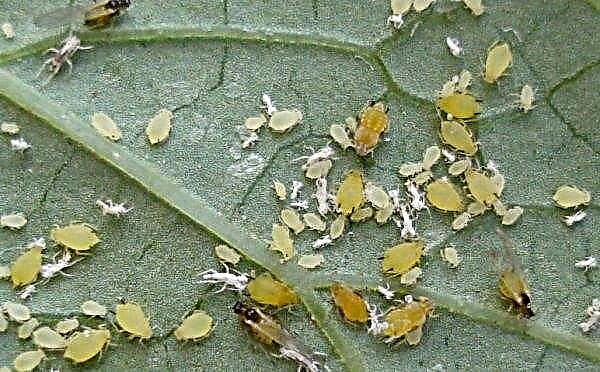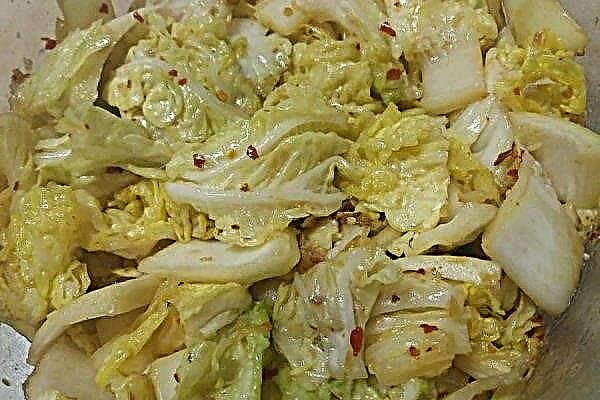Leghorn chickens are a popular breed that is often called leaders among laying hens. They can be found on the courtyards of many poultry farmers. The breed has many advantages and is easy to care for. Over 20 colors of the plumage of this breed are known, but white is most common.
Origin history
The Leggors were bred in the 19th century in Italy and got their name from the city of Livorno (in English pronunciation). At the dawn of development, the breed did not have much egg laying.
Did you know? The official Leghorn productivity record was recorded in 1979 in the USA and amounted to 371 eggs in 364 days.
At the beginning of the 19th century, the Leghorn were brought to the United States, where they were then crossed with white minor, Spanish and fighting chickens, and decorative Japanese varieties. Selection was carried out with selection for precocity and egg production. Advanced birds left for Europe, where each country conducted breeding and breeding, and formed its own populations. In the USSR, the breed was first noted in the 1920s, and the next wave of delivery occurred in the 1960s, when poultry farming became industrial.
In the USSR, the breed was first noted in the 1920s, and the next wave of delivery occurred in the 1960s, when poultry farming became industrial.
White Leghorn breed description
The body of the bird is light, has the shape of a wedge and a wide chest, which corresponds to the classical form of egg-laying chickens. The iris of adults is light yellow, and the young are dark orange.
Appearance
The white leghorn exterior has the following characteristics:
| Head | medium size |
| Crest | in the form of a leaf, standing in roosters straight, in laying hens sideways |
| Beak | short yellow |
| Neck | short, rather long |
| Chest | wide, deep |
| Stomach | volume |
| Wings | small |
| Tail | with a wide base, a slope of 25-40 degrees |
| Paws | thin, medium length; white in adults and yellow in nestlings |
| Plumage and color | snowy white feather |
The tail of the rooster is slightly raised, and the tail of the hen is slightly lowered.
Character
Leghorn - active and hardy, not shy. Birds quickly adapt to their new habitat and live in the southern and northern regions. The breed does not show aggression and gets used to the person who brings the food. Get along well in the same space with other chickens.
Did you know? In the USA and the USSR, Leghorn eggs with nine yolks were recorded.
Advantages and disadvantages
The breed has the following advantages:
- high egg production;
- little need for food;
- early maturity and high survival rate of young animals;
- calm nature.
The disadvantages of leggorn can be considered:
- loss of instinct for hatching eggs;
- a significant decrease in egg production from the second year.
 Advantages of the breed are a consequence of the large selection work of specialists from different countries.
Advantages of the breed are a consequence of the large selection work of specialists from different countries.Other varieties
In addition to white leghorns, there are several other species of the breed that have their own characteristics.
- Brown Leghorn or Partridge Chickens. These birds are characterized by different colors of feathers in the rooster and chicken. Layers are painted in a modest, protective color, and the cock shows shades of golden red and black with a silver and green tint.

- Cuckoo-legged Leghorn. Roosters and hens vary in color immediately after birth. Easy to maintain, active and friendly. They lay medium eggs with a white shell.
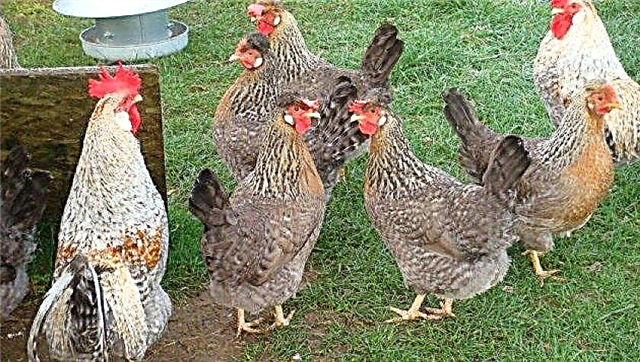
- Golden Leghorns They are distinguished by beautiful color and carry up to 260–265 eggs per year.
- Leggorn spotted ("Dalmatian") - a fairly rare species that accidentally hatched in Scotland. The feathers of birds are black and white, with a predominance of white. Chickens give white eggs.
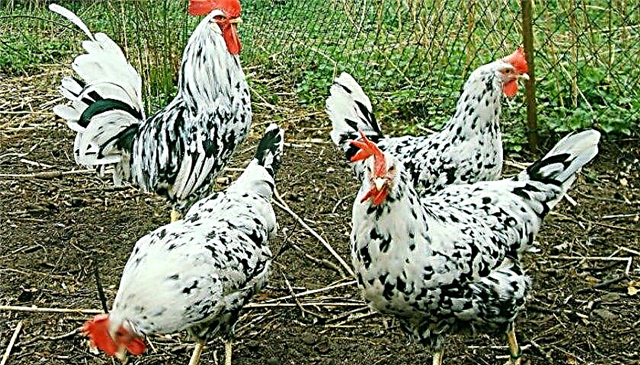
- Dwarf or Mini Leghorn have a dwarf gene, and therefore, small sizes (up to 1, 7 kg of a rooster and up to 1.4 kg of a laying hen). Keep all the advantages of the main breed.
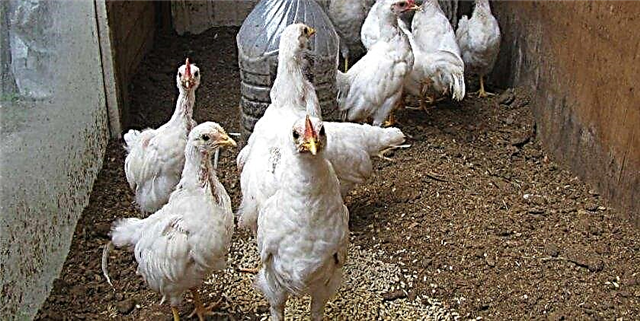
Maintenance and care
The breed is adapted for industrial and household maintenance. Leggors do not require specific care measures, and for housing they will need the simplest structure.
Chicken coop
The calculation of the chicken coop area is based on the norm of 2-3 birds per 1 square meter. For easy cleaning, the shape of the structure should be rectangular, for example, 3x1.5 meters. A summer coop for 10 chickens can be served from the street, and a winter building for a larger number of birds already implies the possibility of entry. Height will depend on the height of the person, so that you do not need to bend inside.
Important! A window is necessary even in a minimal chicken coop, preferably with shutters to adjust the length of daylight hours.
To ensure normal humidity, ventilation must be provided. Perches are located at a height of 80 cm opposite the window. The pole should be easily clasped by the hen's paws. The litter on the floor consists of sawdust or hay and serves to keep the chicken coop clean. Litter layer - from 50 cm. For quick replacement, an additional door is made in the chicken coop in the back wall.
Walking patio
For walks you need a fenced area with grass on the south side. The height of the fence is at least 150 cm. Birds need sun, so the main space should be brightly lit most of the day. Mandatory shadow zone, possibly with a canopy. The area of the courtyard should be 1.5–2 times the area of the chicken coop.
Feeding troughs and drinking bowls
The main requirement for quality equipment is ease of cleaning and the possibility of disinfection. The best feeder for wet food is from metal or plastic, and for dry food, wooden is suitable.
The feeder can be hung on the wall (up to 50 cm from the floor). The drinker should be both inside the chicken coop and on the street. There are automatic drinking bowls and feeders that provide food for chickens in the absence of the owner.
Seasonal molt
Leghorn molt is identical to other breeds. The first change of feather occurs in chickens in 4-8 weeks. Season molting begins in October and lasts up to 8 weeks. The feathers of a bird fall from top to bottom, starting from the neck. To speed up and facilitate the process, iodine, manganese and vitamins are added to the feed.
Herd replacement planned
Leghorn egg production is significantly reduced after a year, and bird keeping may be disadvantageous for farming. Such chickens are often slaughtered, but this is not necessary for personal use. New birds are hatched from eggs in an incubator or a brood of a suitable breed is placed on them.
What to feed
Three meals a day should consist of fresh food, balanced in proteins and minerals. Each age group has its own diet characteristics.
Adult hens
For breakfast and dinner, you can give leggorn barley or wheat with a small addition of vitamins, salt and chalk. Lunch consists of a mixture of vegetables (carrots, potatoes, zucchini, cabbage), herbs and bran. For full development, it is worth supplementing the diet of leggorn with bone meal. Laying hens need calcium and vitamins, which in summer can be obtained from fresh herbs, and in cold weather from supplements and vegetables.
Chickens
For fast growth, babies need more protein. After hatching, they are given yolk and cottage cheese, the next day they are fed with millet. From the fifth day, chalk and greens are added.
Important! Newborn chickens eat six times a day for 10 days.
After three weeks, the chicks can eat food for adult hens, and the number of meals is halved. Leghorns are great for creating a profitable chicken farm because they combine impressive egg production with moderate feed and grooming costs.






